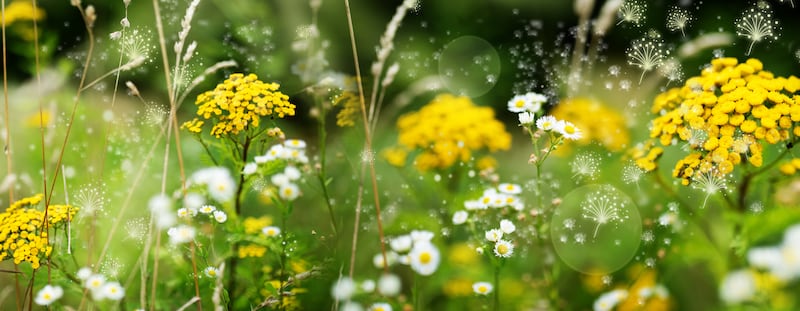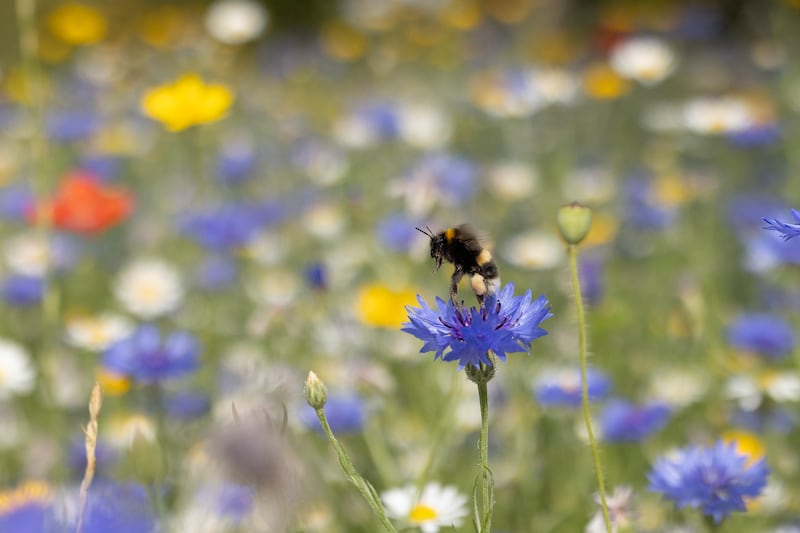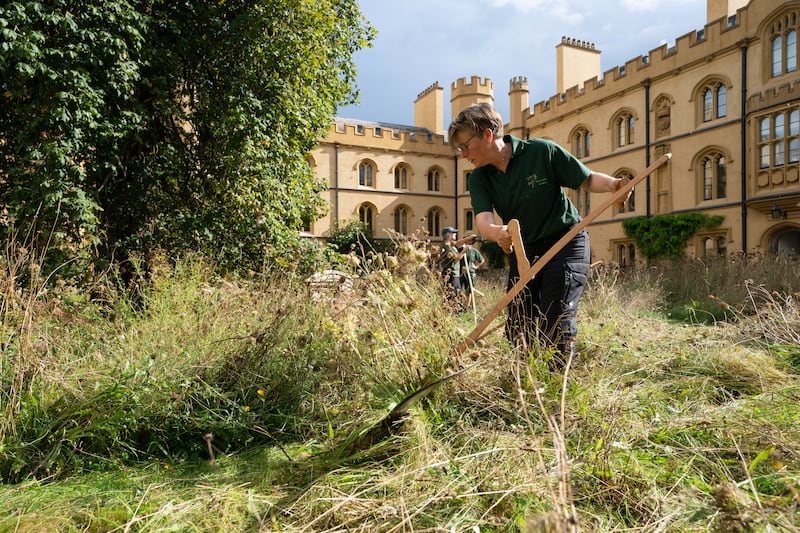As the ludicrously proud owner of a mini-meadow, I spent July like a proud parent, smugly counting common spotted orchids (about 200 so far) and cooing over the graceful pink umbellifers of hedge parsley. But it was the sighting last week of a little group of marsh helleborines in dainty bloom, or Cuaichín corraigh, as this extraordinary Irish wildflower and member of the orchid family is known “as Gaeilge”, that left me giddy with excitement.
Why a species that the distinguished Irish wildflower expert and author Zoe Devlin describes as being typically found in “fens and calcareous marshes, on lake shores, damp pastures and wet dune slacks” is growing in what I’d describe as a fairly dry, free-draining meadow is a bit of a mystery. But perhaps it’s the silver lining to those endless months of rain.
Deliberately stripped of its fertile layer of topsoil almost two decades ago to encourage a wide range of wildflowers, this small, sunny patch of land next to our little farmhouse has evolved into a fascinating, species-rich habitat. Self-heal (Prunella vulgaris), common vetch (Vicia sativa), red and white clover (Trifolium pratense and Trifolium repens), hairy tare (Vicia hirsuta), lesser trefoil (Trifolium dubium), creeping cinquefoil (Potentilla reptans), scarlet pimpernel (Anagallis arvensis), common centaury (Centaurium erythraea), wild yarrow (Achillea millefolium), lady’s bedstraw (Galium verum) and field speedwell (Veronica persica) all also grow here, intermingled with different kinds of fine-leaved grasses and ribwort.
It’s also home to all manner of insects. Tiny moths that rise in gentle clouds as I pick my way carefully through the grass. Butterflies that lazily bask in the sun. Grasshoppers, cleverly camouflaged from predators, whose rhythmic chirping is one of the happy sounds of a hot summer day. Shy yellow meadow ants, their large, dome-shaped heaps bearing testimony to their underground empires where they feed on honeydew farmed from aphids. Beetles, bugs, and the tiniest of bumble bees, their legs laden with yellow pollen. Birds too, including flocks of goldfinches that feed on ripening seed-heads, and yellowhammers hunting for food for their young.
READ MORE
Once upon a time the creation and nurturing of these kinds of native wildflower mini-meadows wasn’t considered a legitimate form of gardening – but not any more. Instead of worrying about how to create the monoculture that is a perfectly velvety, weed-free, moss-free lawn, many Irish gardeners are instead cultivating wildness, and the results are both fun and magical. They’re educational too, as we get to observe the complex, ever-evolving ecosystem of a habitat close up.

Which is not to say that our help isn’t occasionally needed. The truth is that these kinds of meadows need gentle, carefully timed, thoughtful management, if they are to truly flourish. Otherwise, thuggish species take over at the expense of many smaller, less vigorous kinds.
For gardeners eager to quickly establish a native wildflower meadow, it can be tempting to fast-forward the process by sowing a wildflower mix. Bear in mind, however, that most soils already contain an impressively diverse seedbank of native wildflower species waiting in a state of dormancy for the right conditions for germination – the legacy of parent plants that once grew there, often many decades earlier.
‘In native wildflower meadows where diversity is less than hoped for, it’s possible to give it a helping hand – but always with a deep respect for the integrity of any existing local populations of wildflowers’
Seed-bombs, for example, as delightful as they sound, risk introducing a species that has no place in that ecosystem. Even the use of commercially harvested seeds of species of native Irish wildflowers can be problematic, raising the possibility of a subtly different strain being introduced that might adversely impact on established local populations. For this reason, locally sourced seed is always best – again, always harvested sensitively, with a respect for the integrity of the parent plant and its place in the landscape.
That said, in native wildflower meadows where diversity is less than hoped for, it’s possible to give it a helping hand – but always with a deep respect for the integrity of any existing local populations of wildflowers, and the delicate, complex ecosystems of which they’re an important part.
Very small amounts of desired species can be harvested locally by hand. Alternatively, for large areas, a very effective, nature-friendly way to source generous amounts of seed of local populations of wildflowers is to use what’s known as the “green hay transfer” or “strewing” method. In this case, the freshly cut hay from a species-rich local wildflower meadow (the “donor” meadow) is gathered in very late August/very early September, and then quickly spread on the ground of the “receptor” meadow. The latter needs to be similar to the former in the kind of growing conditions it offers (damp/free-draining, sunny/shady, etc).

It also needs to be tightly cut and then either disc-harrowed or scarified in advance to make it as receptive as possible to this rich transfer of ripe wildflower seeds. Greatirishgrasslands.ie offers an excellent overview of native Irish grasslands and meadows.
Another way to increase the range of species (the method we used) is to remove most of the upper layer of top soil to leave a less fertile growing medium behind. This might sound completely counterintuitive, but even a passing glance at the banks and verges surrounding our motorways shows how native wildflowers often flourish in what can seem like the most unpromising of growing conditions.
Yet another way – one that’s slower to carry out, but preserves the contours of the ground and comes without the need for expensive, intrusive machinery work – is to deliberately introduce the hardy hemi-parasitic annual wildflower known as yellow rattle (Rhinanthus minor), a key species in many native meadows. This small hardy annual robs nutrients from the root systems of vigorous perennial grasses such as Yorkshire Fog (Holcus lanatus) and has an unrivalled ability to encourage the establishment of a very biodiverse wildflower meadow.
Although short-lived, it also creates precious growing space for many daintier, less vigorous species that would otherwise struggle to get an initial foothold by dying back in autumn. Flowering in June/early July, its distinctive seed pods (the reason for its common name) are ripening now, and the ripe, fresh, viable seed will soon be ready to harvest. Sown in autumn (scuff small pockets of the surface of the ground, sprinkle the harvested seed onto it and then rub it gently in with your foot), it should emerge in spring.
‘Making a shortlist of the weak spots in your garden’s planting scheme is a useful way to focus on how it can be improved’
Finally, a carefully timed cutting regime where the cut hay is left on the ground for a few days and then collected is another crucial part of the jigsaw. Done in very late August/very early September, it helps to keep fertility levels low as well as encouraging the ripe seed of established species of wildflower to disperse and successfully germinate. Ideally do this with a scythe instead of a noisy strimmer, starting from the inside and working slowly outwards – the traditional way to cut a meadow, and the kindest to wildlife as well as to your neighbours.

This Week
At the risk of repeating myself, a regular regime of water, deadhead, liquid feed; water, deadhead, liquid feed; water, deadhead, liquid feed will do wonders in terms of keeping the show on the road in your garden, well into autumn. Use a high quality liquid seaweed and a sharp, clean secateurs for best results.
Making a shortlist of the weak spots in your garden’s planting scheme is a useful way to focus on how it can be improved. Great garden-worthy species suitable for adding pops of late summer-autumn colour include varieties of sedum, salvia, dahlias, late-flowering types of clematis such as Clematis viticella and C. tangutica, penstemon, agapanthus, helenium, sanguisorba, gaura and hydrangea.
Dates for Your Diary: Saturday, August 24th (3pm-5pm), St Patrick’s Primary School, Church Road, Greystones, the Annual Delgany & District Horticultural Society Dahlia Show takes place with a variety of exhibition-standard dahlias on display. Entries are welcome, please email ddhs.showentries@gmail.com on or before Thursday, August 22nd.

















